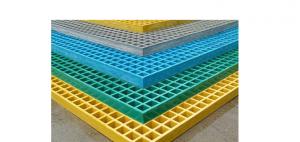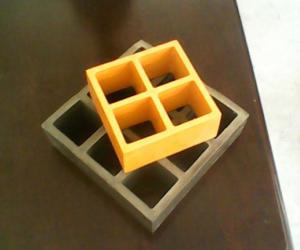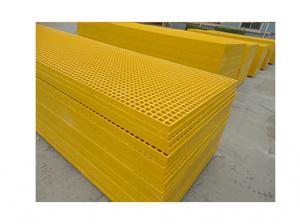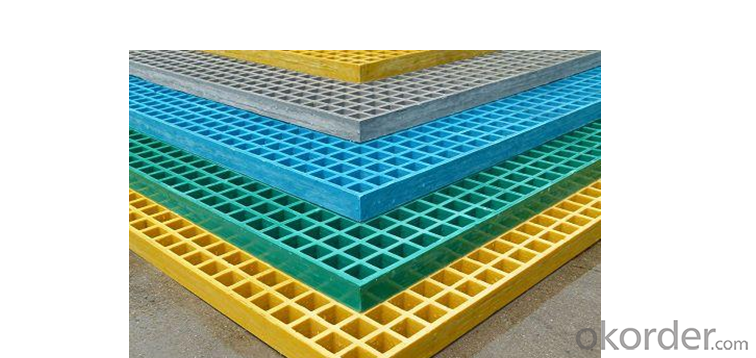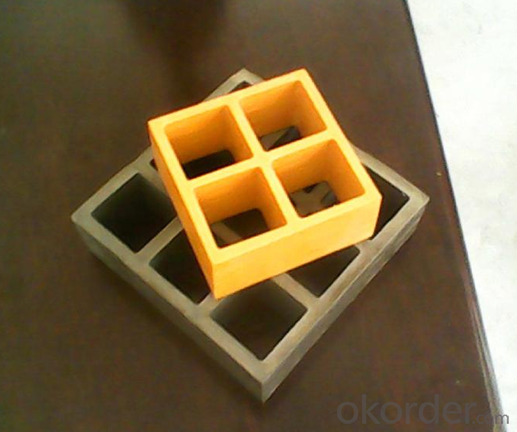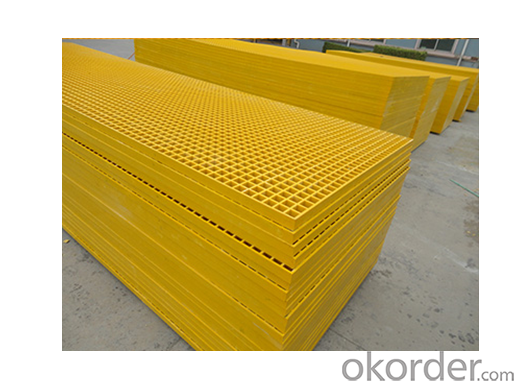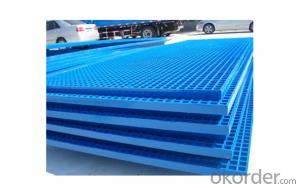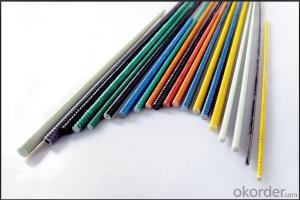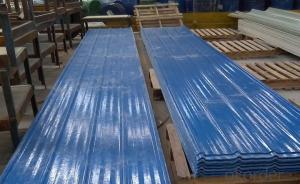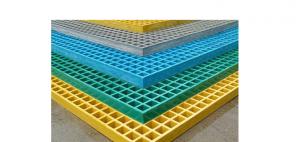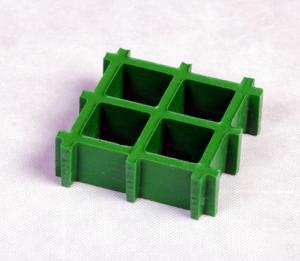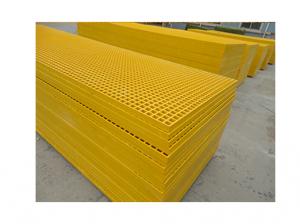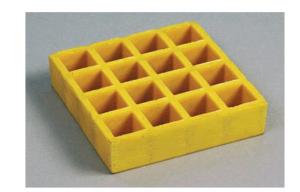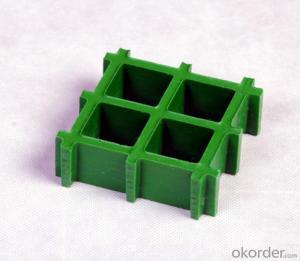FRP Pultrusion Profiles:High Strength, Corrosion Resistant, and Fire Resistant Gratings with Best Quality
- Loading Port:
- China main port
- Payment Terms:
- TT or LC
- Min Order Qty:
- 100 m²
- Supply Capability:
- 500000 m²/month
OKorder Service Pledge
OKorder Financial Service
You Might Also Like
FRP Molded Grating is a structural panel which uses high-strength E-Glass roving as reinforcing material, thermosetting resin as matrix and then casted and formed in a special metal mold. It provides properties of light weight, high strength, corrosion resistance, fire resistance and anti-skid. FRP Molded Grating is widely used in oil industry, power engineering, water & waste water treatment, ocean survey as working floor, stair tread, trench cover, etc. and is an ideal loading frame for corrosion circumstances.
Feature
Corrosion Resistance
Fire Resistance
Light Weight & High Strength
Safety & Anti-slip
Electrical Insulating
Aging Resistance
Specification
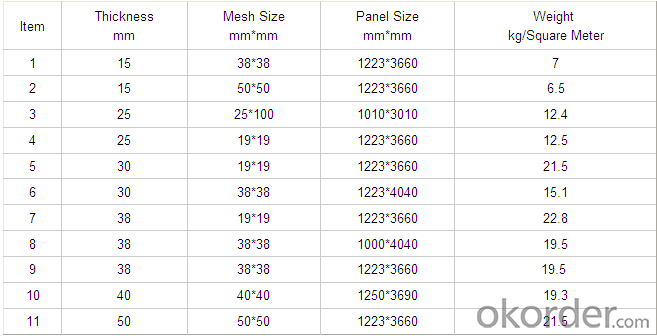
Advantage
coated with prevent aging layer
excellent insulating performance
no maintenance
Application
Power plants, substation equipment enclosures, antimagnetic, anti-static,to prevent small animals into the equipment failure, as there is electricity facilities and without power interval intervals.
Corrosive chemical industry equipment around the fence
All kinds of building maintenance section
FAQ
1. How long is the delivery time?
Usually it takes 10-25days after receipt of the deposits or L/C, and it also depends on the quantity of your order.
2. How's the payment?
Telegraphic Transfer(T/T) or Letter of Credit(L/C)
PROCESS
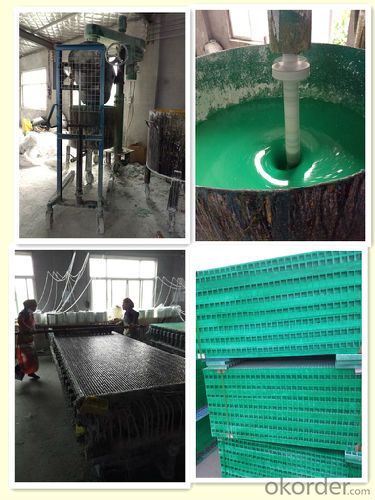
FACTORY
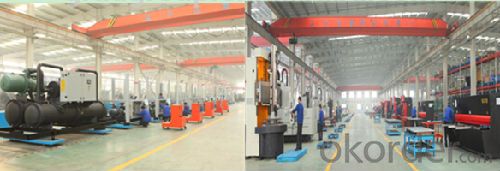

- Q: Are FRP pultrusion profiles resistant to high winds or hurricanes?
- FRP pultrusion profiles offer exceptional resistance against high winds and hurricanes. Combining the robustness of fiberglass with the longevity of polymers, FRP is a lightweight yet remarkably sturdy material that can endure severe weather conditions. Extensive testing has proven that FRP pultrusion profiles exhibit outstanding wind resistance properties. They possess a remarkable stiffness-to-weight ratio, enabling them to withstand the powerful forces generated by high winds without deformation or breakage. Additionally, the inherent flexibility of FRP permits it to absorb and distribute wind forces, minimizing the risk of damage. In the face of hurricanes, FRP pultrusion profiles have demonstrated their capability to withstand the intense winds and airborne debris associated with such extreme weather events. They have been successfully employed in various applications, including building facades, bridges, and utility poles, in areas prone to hurricanes. Moreover, FRP pultrusion profiles possess corrosion resistance, providing an extra advantage in withstanding high winds and hurricanes. Unlike traditional materials like steel or wood, FRP profiles do not rust or decay when exposed to moisture, making them even more suitable for these demanding weather conditions. Overall, with their exceptional strength, durability, flexibility, and corrosion resistance, FRP pultrusion profiles are an excellent choice for applications requiring resistance against high winds or hurricanes.
- Q: Are FRP pultrusion profiles UV-resistant?
- Yes, FRP pultrusion profiles are UV-resistant. The fiberglass reinforcement in the profiles provides excellent resistance to UV radiation, making them suitable for outdoor applications where exposure to sunlight is a concern.
- Q: Are FRP pultrusion profiles resistant to chemicals used in oil refineries?
- FRP pultrusion profiles have a high resistance to chemicals utilized in oil refineries. These profiles consist of a combination of strong fibers (such as fiberglass, carbon fibers, or aramid fibers) embedded in a polymer resin matrix. This unique construction grants them exceptional resistance to various chemicals commonly found in oil refineries. The polymer resin matrix used in FRP profiles can be carefully chosen to withstand harsh chemical environments. For oil refinery applications, vinyl ester or epoxy resins are often employed due to their superior chemical resistance properties. Additionally, FRP pultrusion profiles are inherently corrosion-resistant, unlike traditional materials like steel or concrete that deteriorate when exposed to aggressive chemicals found in oil refineries. This corrosion resistance ensures the long-term durability and reliability of FRP profiles in such environments. Furthermore, FRP profiles offer several other advantages in oil refinery applications, including a high strength-to-weight ratio, electrical insulation, non-magnetic properties, and ease of installation. These characteristics make FRP pultrusion profiles an ideal choice for various structural, piping, and equipment applications within oil refineries. However, it is crucial to consider the specific chemicals and concentrations involved in a particular oil refinery application. While FRP profiles generally exhibit excellent resistance to a wide range of chemicals, there may be highly concentrated or specialized chemicals that could potentially impact their performance. In such cases, it is advisable to seek guidance from FRP manufacturers or experts who can offer tailored solutions to meet the specific chemical resistance requirements of the oil refinery.
- Q: Can FRP pultrusion profiles be used in mining applications?
- Yes, FRP (Fiber Reinforced Plastic) pultrusion profiles can be used in mining applications. FRP pultrusion profiles are known for their high strength-to-weight ratio, corrosion resistance, and durability, making them well-suited for various mining applications. In mining operations, FRP pultrusion profiles can be used for a range of purposes. They can be used for structural support in underground mines, such as in the construction of tunnels, shafts, and mine roofs. Their high strength allows them to withstand heavy loads and provide long-term support. FRP pultrusion profiles can also be used for equipment and machinery support, such as in conveyor systems, pumps, and tanks. Their resistance to corrosion makes them suitable for use in harsh mining environments, where exposure to moisture, chemicals, and abrasive materials is common. Furthermore, FRP pultrusion profiles can be used for safety applications in mining, including handrails, walkways, and grating systems. These profiles can provide reliable and non-slip surfaces, ensuring the safety of workers in mining operations. Overall, FRP pultrusion profiles offer several advantages in mining applications, including their high strength, corrosion resistance, durability, and ease of installation. These qualities make them a viable and cost-effective choice for various mining operations, contributing to improved efficiency and safety in the industry.
- Q: Can FRP pultrusion profiles be used in cooling towers?
- Yes, FRP pultrusion profiles can indeed be used in cooling towers. FRP (Fiber Reinforced Polymer) pultrusion profiles offer excellent corrosion resistance, lightweight construction, and high strength, making them ideal for cooling tower applications. These profiles can withstand the harsh environmental conditions typically found in cooling towers, such as exposure to chemicals, moisture, and temperature variations. Additionally, FRP pultrusion profiles are easy to install, require minimal maintenance, and have a long service life, making them a cost-effective choice for cooling tower construction.
- Q: Are FRP pultrusion profiles resistant to fading or discoloration?
- Yes, FRP (Fiber Reinforced Polymer) pultrusion profiles are highly resistant to fading and discoloration. This is due to the inherent properties of the materials used in their construction. FRP profiles are typically made with a combination of fiberglass reinforcements and a polymer resin matrix, which are both inherently resistant to UV radiation and other environmental factors that cause fading and discoloration. The polymer resin matrix used in FRP profiles is specifically formulated to provide excellent chemical resistance and UV stability, ensuring that the profiles maintain their original color and appearance over an extended period of time. This makes FRP pultrusion profiles an ideal choice for outdoor applications, where exposure to sunlight and other harsh weather conditions is common. Furthermore, the manufacturing process of pultrusion ensures that the color of FRP profiles is consistent throughout their entire cross-section. This means that even if there is minor surface damage or wear, the underlying color of the profile remains the same, ensuring a consistent appearance. Overall, FRP pultrusion profiles offer superior resistance to fading and discoloration, making them a durable and long-lasting option for various applications, such as construction, infrastructure, transportation, and more.
- Q: Are FRP pultrusion profiles resistant to oil or fuel spills?
- Yes, FRP (Fiber Reinforced Polymer) pultrusion profiles are generally resistant to oil or fuel spills. FRP is known for its excellent resistance to a wide range of chemicals, including oils and fuels. The combination of the polymer resin and the reinforcing fibers provides a strong and durable material that can withstand exposure to various substances. FRP pultrusion profiles have a non-porous surface, which makes them impermeable to oil and fuel. This means that even if there is a spill, the profiles will not absorb the substances, preventing any potential damage or degradation. Additionally, FRP is resistant to corrosion and does not react with oils or fuels, ensuring its long-term performance and durability. Due to these properties, FRP pultrusion profiles are commonly used in industries where oil or fuel spills are a concern, such as in oil refineries, chemical plants, and offshore platforms. They offer a reliable solution for applications that require resistance to chemical exposure, providing a cost-effective and low-maintenance alternative to traditional materials.
- Q: Can FRP pultrusion profiles be used in cooling towers?
- Yes, FRP (Fiber Reinforced Polymer) pultrusion profiles can be used in cooling towers. FRP pultrusion profiles offer several advantages that make them suitable for cooling tower applications. Firstly, FRP pultrusion profiles have excellent corrosion resistance, which is essential in a cooling tower environment where exposure to water and chemicals is common. Unlike traditional materials like steel, FRP pultrusion profiles do not rust or corrode, ensuring longer service life and reduced maintenance costs. Secondly, FRP pultrusion profiles have high strength-to-weight ratio, making them lightweight yet strong enough to withstand the structural requirements of cooling towers. This allows for easier installation and transportation, reducing overall project costs. Thirdly, FRP pultrusion profiles have excellent thermal insulation properties. Cooling towers involve the transfer of heat from water to the surrounding air, and the thermal insulation provided by FRP pultrusion profiles helps enhance the efficiency of the cooling process. Lastly, FRP pultrusion profiles are highly customizable and can be designed to meet specific requirements of cooling tower applications. They can be engineered to have various shapes, sizes, and dimensions to fit the specific needs of the cooling tower design. Overall, FRP pultrusion profiles are a reliable and cost-effective choice for cooling tower applications, offering corrosion resistance, high strength-to-weight ratio, thermal insulation, and customization options.
- Q: Are FRP pultrusion profiles resistant to rotting or decaying?
- Yes, FRP (Fiber Reinforced Polymer) pultrusion profiles are highly resistant to rotting or decaying. This is because FRP is composed of a combination of fiber reinforcement, such as fiberglass, and a polymer resin matrix. Unlike traditional materials like wood, which are susceptible to rot and decay when exposed to moisture and environmental elements, FRP pultrusion profiles are non-porous and do not absorb water. Additionally, the polymer resin used in FRP is highly resistant to chemical corrosion, making it unaffected by rot-causing agents such as fungi or bacteria. As a result, FRP pultrusion profiles have a significantly longer lifespan and require minimal maintenance compared to traditional materials, making them an excellent choice for applications where resistance to rotting or decaying is essential.
- Q: Can FRP pultrusion profiles be used in aerospace applications?
- Yes, FRP (Fiber Reinforced Plastic) pultrusion profiles can be used in aerospace applications. FRP materials have several advantages that make them suitable for aerospace use. Firstly, they have excellent strength-to-weight ratios, which is crucial in the aerospace industry to reduce weight and enhance fuel efficiency. Secondly, FRP materials exhibit high corrosion resistance, making them suitable for prolonged exposure to harsh environments, such as high altitude and extreme temperatures. Additionally, FRP pultrusion profiles offer design flexibility, allowing for complex shapes and geometries to be manufactured. This flexibility enables aerospace engineers to tailor the profiles to specific requirements and optimize performance. Furthermore, FRP materials have low thermal conductivity, which helps in insulation applications and reducing heat transfer. Lastly, FRP pultrusion profiles have demonstrated good fatigue resistance, which is essential for aerospace applications subjected to cyclic loading. Overall, these properties make FRP pultrusion profiles a viable choice for various aerospace components, including structural members, interior parts, and electrical enclosures.
Send your message to us
FRP Pultrusion Profiles:High Strength, Corrosion Resistant, and Fire Resistant Gratings with Best Quality
- Loading Port:
- China main port
- Payment Terms:
- TT or LC
- Min Order Qty:
- 100 m²
- Supply Capability:
- 500000 m²/month
OKorder Service Pledge
OKorder Financial Service
Similar products
Hot products
Hot Searches
Related keywords
